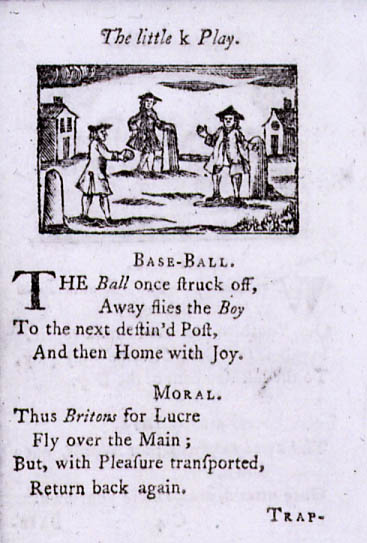The Little Pretty Pocket Book (intended for the Amusement of Little Master Tommy and Pretty Miss Polly with Two Letters from Jack the Giant Killer) is often regarded as the first children’s book. Certainly, it was one of the first marketed at children (or at least, at their parents).
Although no masterpiece of literature, it is a masterpiece of marketing. The book is tremendously small, no larger than 8cm. Even the fairly diddy modern reprint has the actual text of the book make up a rather small amount of paper. This sets it aside from the ‘adult’ books, as well as being a good way saving paper. What’s more, the original book was bound in an attractive, colourful cover, meaning that it was both pretty and little.
Another attraction of the book, are the illustrations on almost every page. These are fairly crude little woodblocks but they do completely match the text, suggesting they were created specifically for it.
Finally, for an extra tuppence, the book came with a free gift in a bag. A ball for a boy and a pincushion for a girl. (I feel the girls were a little shortchanged in this regard). Not only does it bring a ‘happy meal’ free toy quality to the book, it was actually sold to the parent as a behaviour management tool. Both ball and pincushion were red on one side and black on the other, and both had a set of pins. The ball wasn’t actually for throwing, but for hanging up, as was the pincushion. When the child did a good act, the pin was stuck in the red side, and when they did a bad, a pin was stuck in the black. Ten pins in the good side deserves a reward (the suggestion is a penny) and ten in the black a punishment (a cane is suggested here).
What Newbery realised, and Samuel Johnson picked up on, was that the book, though marketed to appeal to children, was actually sold to the parents. The book actually begins with a little address to the parents, outlining the latest research in child development from Locke and encouraging parents to correct a child’s behaviour, “in such a manner, as to forward his Enquiries, and pave his Grand Pursuit (of learning) with Pleasure.” There then follows a letter from ‘Jack the Giant Killer’ to the child, detailing the use of ball or pincushion.
Then the book goes broadly alphabetically, with each letter represented by a game. The game is pictured, a little rhyme describes it, then another points out the ‘moral of the game’. For example, the moral of flying a kite is to associate the joy of the flying kite, with thankfulness to God… the morals are often a little tenuous.
The games are varied. There are some like kite-flying, swimming, leap-frog and hopscotch, which are still played today. Some activities, like bird nesting are very much not encouraged anymore. Some like thread-the-needle and I-sent-a-letter-to-my-love, are variations of skipping games that aren’t as well known. Newbery even includes squares, a ‘well invented game’, which he invented himself and sold in his shop. Americans are often excited by the first reference to the game baseball, though the game portrayed is closer to rounders.
The book then goes through another alphabet, and then some retellings of Aesop’s fables, with the morals again explained by ‘Jack the Giant Killer’. Then there’s an aimless few pages, which represents good children displaying good behaviours like reading ‘in a pretty manner’ and shows how everyone loves them. This is followed by some poems personifying the four seasons, and some proverbs such as ‘the eye is bigger than the belly’. Finally, and most importantly, there’s a list of other children’s works and games available from Newbery’s shop.
It’s easy to see the attraction of a book of one’s own, especially in a time poorer in books than now. It’s also possible to see that the contents could have been enjoyable to the children it was written for, although there is always a moral just around the corner, the subject of the book is largely play, featuring many different games. The modern children I showed the book to were certainly not impressed but The Pretty Little Pocket Book was loved by those it was written for. Not only did it go into many editions and was quite obscenely pirated, especially in the American Colonies, not one single copy of the first few editions survive - they were presumably loved to death.
Johnson was adamant that, ”babies do not want to hear about babies” but many modern children’s books prove that they do. Everyone likes a little representation in their media and children are no different. I’m sure The Little Pretty Pocket Book did excite recognition in its original audience, something other than chapbook versions of A Pilgrim’s Progress and tales of Arthurian knights. Children then and now, like everyone else, enjoy variety in their reading experiences and this book offered something different.
Next week, I’ll be writing about something very different.




No comments:
Post a Comment